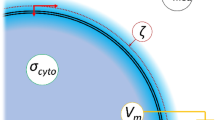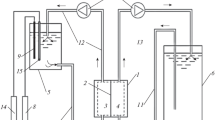Summary
The rate of dissipation of a pH gradient across the red cell membrane has been measured at pH 5.7–7.5 in a medium free of CO2 and other penetrating acids or bases. The measured rates and extents of pH movements are influenced only slightly by valinomycin-induced changes in the membrane potential. This indicates that the primary process involved is electrically silent OH−/Cl− exchange or H+/Cl− cotransport. This electrically silent pH equilibration has several characteristics which suggest the involvement of the red cell anion exchange protein.
-
1.
It is strongly inhibited by phloretin and DIDS (4,4′-diisothiocyano-2,2′-stilbenedisulfonic acid).
-
2.
The rates of pH equilibration depend on the halide present in the medium, the relative rates being 100, 18, and 2 in NaCl, NaBr, and NaI media, respectively.
-
3.
The pH equilibration has apparent activation energies of 27 kcal/mol atT<13°C and 16 kcal/mol atT>13°C.
The pH dependence of the equilibration rate, however, is much more consistent with H+/Cl− cotransport than with OH−/Cl− exchange; the rate increases steeply with the H+, rather than the OH− concentration. It is suggested therefore that the transport event is H+/Cl− cotransport, but that this transport is mediated by the membrane protein that catalyzes anion exchange.
Similar content being viewed by others
References
Brahm, J. 1977. Temperature-dependent changes of chloride transport kinetics in human red cells.J. Gen. Physiol. 70:283
Cabantchik, Z.I., Rothstein, A. 1974. Membrane proteins related to anion permeability of human red blood cells.J. Membrane Biol. 15:207
Chow, E.I., Crandall, E.D., Forster, R.E. 1976. Kinetics of bicarbonate-chloride exchange across the human red blood cell membrane.J. Gen. Physiol. 68:633
Cousin, J.L., Motais, R., Sola, F. 1975. Transmembrane exchange of chloride with bicarbonate ion in mammalian red blood cells: Evidence for a sulphonamide-sensitive “carrier”.J. Physiol. (London) 253:385
Crandall, E.D., Klocke, R.A., Forster, R.E. 1971. Hydroxyl ion movements across the human erythrocyte membrane.J. Gen. Physiol. 57:664
Dalmark, M. 1975. Chloride transport in human red cells.J. Physiol. (London) 250:39
Dalmark, M. 1976a. Chloride in the human erythrocyte. Distribution and transport between cellular and extracellular fluids and structural features of the cell membrane.In: Progress in Biophysics and Molecular Biology. J.A.V. Butler and D. Noble, editors. Vol. 31, p. 145 Pergamon, Oxford
Dalmark, M. 1976b. Effects of halides and bicarbonate on chloride transport in human red blood cells.J. Gen. Physiol. 67:223
Dalmark, M., Wieth, J.O. 1972. Temperature dependence of chloride, bromide, iodide, thiocyanate, and salicylate transport in human red cells.J. Physiol. (London) 224:583
Deuticke, B. 1972. The transmembrane exchange of chloride with hydroxyl and other anions in mammalian red blood cells.In: Oxygen Affinity of Hemoglobin and Red Cell Acid-BAse Status. M. Rørth and P. Astrup, editors p. 307. Munksgaard, Copenhagen
Duhm, J. 1972. The effect of 2,3-DPG and other organic phosphates on the Donnan equilibrium and the oxygen affinity of human blood.In. Oxygen Affinity of Hemoglobin and Red Cell Acid-Base Status. M. Rørth and P. Astrup, editors. p. 583. Munksgaard, Copenhagen
Duhm, J. 1976. Influence of 2,3-diphosphoglycerate on the buffering properties of human blood.Pfluegers Arch. 363:61
Forster, R.E. 1972. The effect of pH on the OH− permeability of human red cells at 37°C.In: Oxygen Affinity of Hemoglobin and Red Cell Acid-Base Status. M. Rørth and P. Astrup, editors. p. 335. Munksgaard, Copenhagen
Funder, J., Wieth, J.O. 1966. Chloride and hydrogen ion distribution between human red cells and plasma.Acta Physiol. Scand. 68:234
Funder, J., Wieth, J.O. 1976. Chloride transport in human erythrocytes and ghosts: A quantitative comparison.J. Physiol. (London) 262:679
Gunn, R.B. 1972. A titratable carrier model for both mono- and divalent anion transport in human red blood cells.In: Oxygen Affinity of Hemoglobin and Red Cell Acid-Base Status. M. Rørth and P. Astrup, editors. p. 823. Munksgaard, Copenhagen.
Gunn, R.B. 1973. A titratable carrier for monovalent and divalent inorganic anions in red blood cells.In: Erythrocytes, Thrombocytes, Leucocytes. E. Gerlach, K. Moser, E. Deutsch, and W. Wilmanns, editors. p. 77. Georg Thieme Verlag, Stuttgart
Gunn, R.B., Dalmark, M., Tosteson, D.C., Wieth, J.O. 1973. Characteristics of chloride transport in human red blood cells.J. Gen. Physiol. 61:185
Hladky, S.B., Rink, T.J. 1976. Potential difference and the distribution of ions across the human red blood cell membrane: A study of the mechanism by which the fluorescent cation di S-C3-(5) reports membrane potential.J. Physiol. (London) 263:287
Ho, M.K., Guidotti, G. 1975. A membrane protein from human erythrocytes involved in anion exchange.J. Biol. Chem. 250:675
Hoffman, J.F., Laris, P.C. 1974. Determination of membrane potentials in human andamphiuma red blood cells by means of a fluorescent probe.J. Physiol. (London) 239:519
Jacobs, M.H., Parpart, A.K. 1932. Is the erythrocyte membrane permeable to hydrogen ions?Biol. Bull. 42:63
Jacobs, M.H., Stewart, D.R. 1942. The role of carbonic anhydrase in certain ionic exchanges involving the erythrocyte.J. Gen. Physiol. 25:539
Jennings, M.L. 1976. Proton fluxes associated with erythrocyte membrane anion exchange.J. Membrane Biol. 28:187
Kaplan, J.H., Passow, H. 1974. Effects of phlorizin on net chloride movements across the valinomycin-treated erythrocyte membrane.J. Membrane Biol. 19:179
Katchalsky, A. 1967. Membrane thermodynamics.In: The Neurosciences, A study Program. G.C. Quarton, T. Melnechuk, and F.O. Schmitt, editors. p. 326. Rockefeller University Press, New York
Kedem, O., Katchalsky, A. 1958. Thermodynamic analysis of the permeability of biological membranes to nonelectrolytes.Biochim. Biophys. Acta 27:229
Knauf, P.A., Fuhrmann G.F., Rothstein, S., Rothstein, A. 1977. The relationship between anion exchange and net anion flow across the human red blood cell membrane.J. Gen. Physiol. 69:363
LeFevre, P.G. 1961. Sugar transport in the red blood cell: Structure-activity relationships in substrates and antagonists.Pharmacol. Rev. 13:39
Macey, R.I., Farmer, R.E.L. 1970. Inhibition of water and solute permeability in human red cells.Biochim. Biophys. Acta 211:104
Passow, H., Fasold, H., Zaki, L., Schuhmann, B. Lepke, S. 1974/1975. Membrane proteins and anion exchange in human erythrocytes.In: Biomembranes: Structure and Function. G. Gárdos and I. Szász, editors. (FEBS Symposia Series) Vol. 35, p. 197. North Holland, Amsterdam, and Publishing House of the Hungarian Academy of Sciences, Budapest
Passow, H., Wood, P.G. 1974. Current concepts of the mechanism of anion permeability.In: Drugs and Transport Processes. B.A. Callingham, editor. p. 149. Macmillan, London
Sachs, J.R., Knauf, P.A., Dunham, P.B. 1975. Transport through red cell membranes.In: The Red Blood Cell. D.M. Surgenor, editor. (2nd ed.) Vol. II, p. 613. Academic Press, New York
Scarpa, A., Cecchetto, A., Azzone, G.F. 1970. The mechanism of anion translocation and pH equilibration in erythrocytes.Biochim. Biophys. Acta 219:179
Schnell, K.F. 1972. On the mechanism of inhibition of the sulfate transfer across the human erythrocyte membrane.Biochim. Biophys. Acta 282:265
Schnell, K.F., Gerhardt, S., Schöppe-Fredenburg, A. 1977. Kinetic characteristics of the sulfate self-exchange in human red blood cells and red blood cell ghosts.J. Membrane Biol. 30:319
Tosteson, D.C. 1959. Halide transport in red blood cellsActa Physiol. Scand. 46:19
Tosteson, D.C., Gunn, R.B., Wieth, J.O. 1973. Chloride and hydroxyl conductance of sheep red cell membrane.In: Erythrocytes, Thrombocytes, Leucocytes. E. Gerlach, K. Moser, E. Deutsch, and W. Wilmanns, editors. p. 62. Georg Thieme Verlag, Stuttgart
Van Slyke, D.D., Wu, H., McLean, F.C. 1923. Studies of gas and electrolyte equilibria in the blood. V. Factors controlling the electrolyte and water distribution in the blood.J. Biol. Chem. 56:765
Warburg, E.J. 1922. Studies on carbonic acid compounds and hydrogen ion activities in blood and salt solutions.Biochem. J. 16:153
Wieth, J.O., Dalmark, M., Gunn, R.B., Tosteson, D.C. 1973. The transfer of monovalent inorganic anions through the red cell membrane.In: Erythrocytes, Thrombocytes, Leucocytes. E. Gerlach, K. Moser, E. Deutsch and W. Wilmanns, editors. p. 71. Georg Thieme Verlag, Stuttgart
Author information
Authors and Affiliations
Rights and permissions
About this article
Cite this article
Jennings, M.L. Characteristics of CO2-independent pH equilibration in human red blood cells. J. Membrain Biol. 40, 365–391 (1978). https://doi.org/10.1007/BF01874164
Received:
Revised:
Issue Date:
DOI: https://doi.org/10.1007/BF01874164




